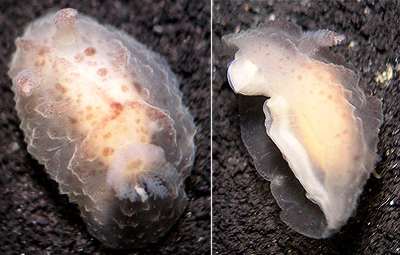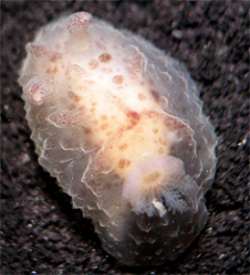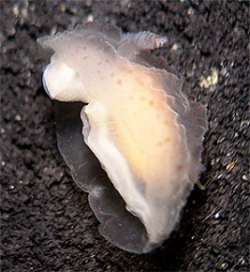
Hallaxa apefae
Marcus, 1957
Order: NUDIBRANCHIA
Suborder: DORIDINA
Superfamily: EUDORIDOIDEA
Family: Actinocyclidae
DISTRIBUTION
Amphiatlantic. Known from West Africa (Ghana) and Sth America (Brazil).
PHOTO
Rocky shore, Rio de Janeiro, Atlantic, 22 February 2006, Intertidal. Length: 6 mm. Photographer: Vinicius Padula
The body has a smooth, firm, jelly-like consistency. It is a translucent hyaline yellow colour with irregular brownish spots. There is a median ridge which runs from between the rhinophores back to the gill pocket, where it divides to encircle the gill pocket. There are also scattered irregular tubercles over the mantle. The gills, about 8, are simple and form a goblet shaped circlet, typical of the genus.
This species was previously known from only two individuals, one from Ubatuba, Brazil (7 mm long) and one from Ghana (14 mm long). It is clearly very cryptic. As I mention elsewhere [#16203 ] it may be worth looking carefully at halisarcid sponge colonies for further animals.
-
Gosliner, T.M. & Johnson, S. (1994) Review of the genus Hallaxa (Nudibranchia: Actinocyclidae) with descriptions of nine new species. The Veliger, 37(2): 155-191.
-
Marcus, E. (1957) On Opisthobranchia from Brazil (2). Journal of the Linnean Society of London, Zoology, 43: 390-486.
-
Ortea, J., Valdés, A. & Templado, J. 1997. Hallaxa apefae Marcus, 1957 (Nudibranchia: Actinocyclidae) from Ghana (West Africa), newly recognized as an amphiatlantic species. The Veliger, 40: 86-88.
Rudman, W.B., 2006 (March 30) Hallaxa apefae Marcus, 1957. [In] Sea Slug Forum. Australian Museum, Sydney. Available from http://www.seaslugforum.net/find/hallapef
Related messages
Re: Unknown translucent dorid from Brazil
April 1, 2006
From: Vinicius Padula
Concerning message #16203:
Angel and Bill,
I found 2 specimens but they were on rock without any sponge. I don´t know any halisarcid, you can send to me a photo about this sponge group to look in future divings ?
Best wishes,
Vinicius Padula
viniciuspadula@yahoo.com
Padula, V., 2006 (Apr 1) Re: Unknown translucent dorid from Brazil. [Message in] Sea Slug Forum. Australian Museum, Sydney. Available from http://www.seaslugforum.net/find/16213Dear Vinicius,
One of the problems with the Halisarcida is that often they don't look like sponges at all - they often look like a thin layer of rubbery plastic over a rock. Actually I once took a rock to a sponge expert - who I won't embarass by naming - who insisted that what I was showing him was a compound ascidian, and only changed his mind a few months later when he examined it microscopically. There might not have been any sponge on your rock, but it is also possible there was a small colony of a halisarcid which didn't look like a sponge. There is a good photo of the Atlantic species, Halisarca dujardini on Bernard Picton's site at:
http://www.habitas.org.uk/marinelife/species.asp?item=C9100
and have a look at the Fact Sheet for Hallaxa chani where the photo shows the animal on another species of Halisarca. I also have a photo of another half-eaten colony of Halisarca which I'll post in a day or so
Best wishes,
Bill Rudman
Re: Unknown translucent dorid from Brazil
March 31, 2006
From: Angel Valdes
Concerning message #16159:
Bill and Vinicius,
I believe this is Hallaxa apefae Marcus, 1957. For a description see:
-
Ortea, J., Valdés, A. & Templado, J. 1997. Hallaxa apefae Marcus, 1957 (Nudibranchia: Actinocyclidae) from Ghana (West Africa), newly recognized as an amphiatlantic species. The Veliger, 40: 86-88.
Best regards,
Angel
avaldes@nhm.org
Valdes, A., 2006 (Mar 31) Re: Unknown translucent dorid from Brazil. [Message in] Sea Slug Forum. Australian Museum, Sydney. Available from http://www.seaslugforum.net/find/16203Dear Angel,
I fully agree with your suggestion. I thought it looked like a Hallaxa or Actinocyclus but for some reason couldn't fit the photo with Marcus's or your earlier description. I guess the median ridge is not clear in Vinicius's photo. But on rechecking, following your remarks, I don't know why I was so hesitant. Thanks for sorting that out.
Vinicius, it would be very interesting to find out what sponge this animal feeds on. Ortea, Valdes & Templado (1997) mention the one specime they found was very well camouflaged on its sponge. A number of actinocyclids feed on halisarcid sponges, which are often called 'slime sponges' because they look like a layer of slimy jelly or plastic on the rocks, and lack any spiculate skeleton. It would be interesting to know if this species also feeds on a halisarcid sponge.
Best wishes,
Bill Rudman
Unknown translucent dorid from Brazil
March 30, 2006
From: Vinicius Padula

Dear Bill,
I have no idea about this specimen.
Locality: Rockshore, 1 metre, Rio de Janeiro, Atlantic, 22 February 2006, Intertidal. Length: 6mm. Photographer: Vinicius Padula.
Best wishes,
Vinicius Padula
viniciuspadula@yahoo.com
Padula, V., 2006 (Mar 30) Unknown translucent dorid from Brazil. [Message in] Sea Slug Forum. Australian Museum, Sydney. Available from http://www.seaslugforum.net/find/16159
Dear Padula,
I'm afraid it doesn't look familar to me. One possibility is Actinocyclus or Hallaxa, both of which have similar gills and body shape, but I don't know of an Atlantic species which matches. Hopefully someone will give us some help
Best wishes,
Bill Rudman
